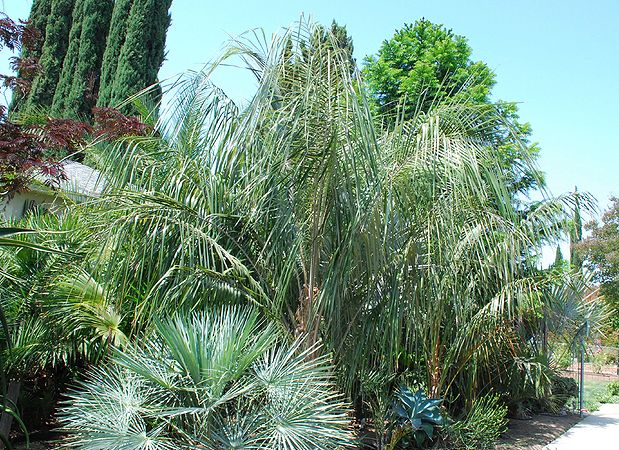Pronunciation: pair-uh-joo-BAY-uh SOON-kuh
Common Name:
Parajubaea sunkha was once a very rare palm for California, but over the last 10 years has become much more available and is turning out to be one of the very best landscape palms there are. It also is one of the few palms that grows far better here in California that anywhere else in the US (including Hawaii). Unlike other members of this genus, Parajubaea sunkhas are pretty reliable and rarely 'konk out' for unknown reasons as the other two Parajubaeas do occasionally. This species seems to be a more wind tolerant one than the other Parajubaeas as well. This is not a particularly tall palm, so good for growing under power lines. And still uncommon enough to be a conversation piece once near maturity.
|
Appearance and Biology
- Habit: solitary with a crown of 20-30 leaves
- Height: 20' estimated
- Trunk: single; covered with fibrous weave at least over its upper portion; 14" in diameter approximately
- Crownshaft: none
- Spread: 15'-16'
- Leaf Shape and color: pinnate, long (11'), arching, flat, sometimes with a bit of a twist; leaves come off trunk at slight angle (not parallel to trunk); leaflets bright green on top/silvery underneath, very long and straight, induplicate, coming off rachis slightly pinched
- Petiole: 18" long, unarmed, half circle in cross-section (flat on top) with unsplit leaf bases
- Reproduction: monoecious
- Inflorescence:
- Fruit:
- Seed:
|
Horticultural Characteristics
- Minimum Temp: 25F with some foliar damage if a younger palm
- Drought Tolerance: moderate
- Dry Heat Tolerance: good
- Wind Tolerance: moderate though arid winds can be pretty damaging over time
- Salt Tolerance: unknown (suspect poor)
- Growth Rate: slow to moderate with time
- Soil Preference: very adaptable and seems to prefer rich and somewhat heavy soils
- Light Requirement: full to partial sun
- Human Hazards: none
- Disease or Horticultural Problems: none known
- Transplants?: so far this seems to be a poorly tolerant transplanter
- Indoor?: unknown but unlikely to do well
- Availability: rare but available from palm local palm specialists (not a good palm for Hawaii or Florida, so usually has to be acquired locally)
|























